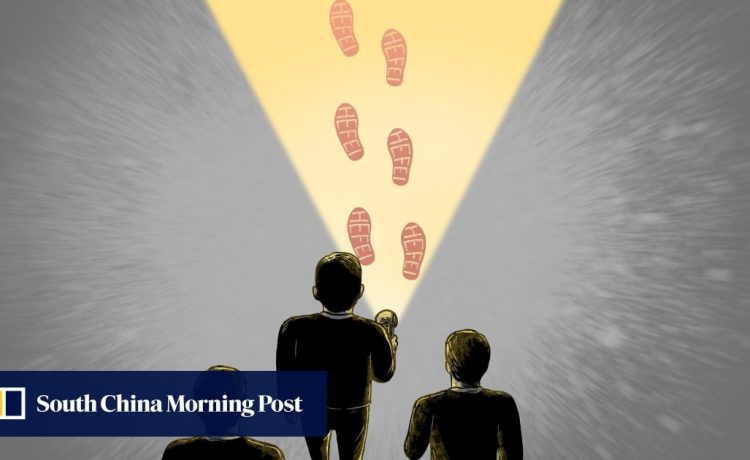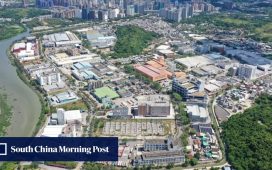Where 20 years ago farmland stretched as far as the eye could see, the vista has been replaced by skyscrapers, bridges and clusters of modern industrial plants. Where residents used to keep pig pens outside their homes, a city centre now stands.
Hefei is rare in that its successive administrations have maintained a consistent approach
In the week of April 10 alone, two high-level delegations – headed by leaders from Hunan province and the Beijing municipality – paid a visit to the city’s quantum computing lab, artificial sun research institutions and new energy vehicle factories.
Visiting officials are keen to learn Hefei’s formula for success: how an industrial backwater could catch up and excel in such a short period, and how it defied the national population decline by attracting an influx of nearly 220,000 new residents last year.
“Hefei is rare in that its successive administrations have maintained a consistent approach to [tech and advanced manufacturing] investment despite personnel changes,” said Xu Tianchen, a senior China economist with the Economist Intelligence Unit.
Analysts largely attribute the city’s extraordinary economic rise – its gross domestic product ranking has catapulted from 76th two decades ago to 20th last year – to a visionary and enterprising local leadership and their successful bet on some of the most promising industries, including new energy vehicles.
It is viewed as a poster child for Beijing’s strategic shift to focus on technological innovation and advanced manufacturing to drive economic expansion.
Hefei is also viewed as a good example of how authorities can maximise the potential of combining enterprising governments and an effective market, rather than pick up free market ideas from Western countries or a return to the old era of a command or planned economy.
‘New productive forces’: empty rhetoric, or engine for China’s future growth?
‘New productive forces’: empty rhetoric, or engine for China’s future growth?
“Such consistency is very hard to replicate given that city party secretaries spend less than four years in a location on average, which means the construction period alone could outlast their terms,” Xu added.
“Many cities actually don’t know what industries they should develop, hence they lay out the same industrial plan and pick industries that everyone else invests in. This differs Hefei from many other follower cities that are late in the game.”
Such an approach, theorised by former World Bank chief economist Justin Lin Yifu as new structural economics, was clearly stated in this year’s government work report, and is seen as vital to China’s painful economic transition.
While many local Chinese leaders splash money on roads, property and industrial projects that could bring them GDP growth, and therefore boost their chance of getting a promotion, provincial and municipal officials in Anhui have set their sights firmly on future industries and became actively involved in creating an industrial ecosystem through a variety of seed funds, land support and tax incentives.
[The government’s organisation] impressed the Continental project team that they have good confidence in the future development of this city
When Continental, the world’s fourth-largest tyre manufacturer, set foot in the city in 2009, it had thought a lot about the sufficient labour force – the province has a population of 61 million, slightly lower than the size of France – and its geological location adjoining China’s thriving Yangtze River Delta.
“The government showed very professional and efficient organisation,” said Wang Xiaoji, a plant manager at Continental Tires (China), adding that Continental had ramped up its investment in China to 4 billion yuan (US$552 million) this year.
“That impressed the Continental project team that they have good confidence in the future development of this city.”
In addition to manufacturing plants in Anhui, Continental also has a research and development (R&D) centre, including state-of-the-art testing and pilot facilities
Hefei’s push for technology and manufacturing is also backed by its talent pool as it houses some of China’s top research facilities, including the University of Science and Technology of China, as well as several institutions under the Chinese Academy of Sciences.
And Now, a decade of cultivation has begun to bear fruits.
Anhui produces around 9 per cent of China’s new energy vehicles after it laid out the welcome mat to private carmakers.
A tenth of China’s battery power output, an eighth of its solar cell production, a third of its photovoltaic power generation equipment and half of the photovoltaic glass output is produced in the province, local government data showed.
There is also an army of emerging industrial enterprises of around 6,800, which contributed more than 60 per cent of the province’s industrial economic growth last year.
Electric vehicles, solar and lithium-ion batteries are the “new three” products hailed by Beijing after their exports rose by 29.9 per cent year on year to 1.06 trillion yuan (US$146 billion) in 2023, offering an important bright spot for the national economy.
Yet questions loom large. Can the Hefei model, or China Inc’s new strategy, be the beacon guiding China out of its economic quagmire, especially when Beijing is facing US tech containment efforts and being at a key juncture of becoming a high-income country.
At local levels, doubts remain over whether its success can be replicated elsewhere.
There are not that many of these really promising industries out there
“There might be room for one Hefei or two, but when everybody wants to get a piece of the pie in the industries of the future and emerge above, it’s kind of excessive competition and in many ways duplication,” Ries said.
“[These cities] are not really pursuing different technologies, and there are not that many of these really promising industries out there.”
Yellen in China: ‘difficult conversations’, overcapacity spat add to tensions
Yellen in China: ‘difficult conversations’, overcapacity spat add to tensions
China would hold more than 80 per cent of the world’s solar manufacturing capacity, including polysilicon, wafers, cells and modules by 2026, according to data and analytics firm Wood Mackenzie.
And last year, two thirds of the world’s electric vehicles were already made in China, according to a PwC report.
It has been facing pressure from both sides of the Atlantic over accusations that cheap Chinese exports are flooding international markets, risking pricing home-grown industries out of their own markets.
While concerns persist about unsustainable stockpiles, Beijing has argued that China’s overcapacity in the clean energy sector is a healthy sign and a necessary phase in the process of development, and will be temporary as global demand for green transition will remain.
Reis said that the dynamics of competition between local governments in China is what makes the stockpiles unsustainable, and that it is still early to tell as the worst part of solar overcapacity has not yet hit.
But when it does, companies would undoubtedly be affected by underutilisation and stockpiles, he added.
Wei Hongxu, an analyst with independent think tank Anbound, said Hefei proved to Beijing that local governments can become professional investors and participate in the investment process.
“The success … is a result of respecting market principles and exploring an effective mechanism and pathway for government-owned assets to participate in industrial and venture investments,” he said.
Wei, however, pointed out a “bad apple” scenario, in which local enthusiasm for certain industries may fail, wasting taxpayer’s money and adding to already-high debt piles.
With investment surpassing 126 billion yuan (US$17.4 billion) between 2015 and 2017, neighbouring Jiangxi province bolstered its new energy vehicle manufacturing capabilities to 2.15 million units by 2017, surpassing even the economic powerhouses of the Pearl and Yangtze River Delta regions.
The substantial investment resulted in a 57 per cent economic expansion by 2018 compared to five years earlier.
But, contrasting with Hefei’s achievements, most of the ventures are now bankrupt or at a standstill due to excessive investment and a lack of industrial research and proper management.
“Most areas are accustomed to land development and infrastructure investment models, they lack effective experience in more specialised and higher-risk venture or industrial investments,” Wei added.
Hefei’s success is not so easy to replicate
There are already lots of failures across China, from ghost towns to deserted highways in mountainous regions in the west.
“Hefei’s success is not so easy to replicate. It relies on the fortuitous combination of factors, right timing, location and people, a higher tolerance for mistakes, and many daring officials willing to take action,” said Pan Feng, chief economist at the Anhui provincial department of industry and information technology.
But local bets on certain industries are also based on comprehensive industrial research and consultation with professional consultancies, officials from Hefei said during a media tour in late March.
Beijing needs to switch to hi-tech and innovative solutions as it tries to promote long-term and sustainable growth, as well as preventing being strangled by the US, analysts said.
Local authorities have tried to build Hefei into a powerhouse for innovation and cutting-edge technologies and fostered industrial hubs including high-end manufacturing, electric vehicles, clean energy production, biotech and semiconductors.
Also, to embed innovation deeply into local corporate culture, Anhui has vowed to ask all manufacturing enterprises with annual revenue of above 20 million yuan to pursue R&D centres and activities.
“The provincial government will try to learn their needs – why have these companies with annual revenues exceeding 100 million or 500 million yuan not established R&D institutions?” said Zhang Yun, deputy head of the province’s economic planning commission.
“And in response to their challenges and issues, we will integrate resources and services to provide targeted and systematic assistance.”
The province has identified the low-altitude economy, a comprehensive realm of industries centred on civil-manned and unmanned aerial vehicles, as one of its next pillar industries for growth.
China’s eVTOL craft gets clearance as ‘low-altitude economy’ prepped for launch
China’s eVTOL craft gets clearance as ‘low-altitude economy’ prepped for launch
To keep the manufacturer’s production base and east China headquarters in the city, the Hefei municipal government has promised US$100 million of support in various forms, including facilitating purchase orders of no less than 100 units.
“Both Anhui province and Hefei City are at the forefront of China’s low-altitude economic development,” said Ehang public relations manager Zoe Li.
The government said the scale of the industry in the province surpassed 40 billion yuan in 2023.










